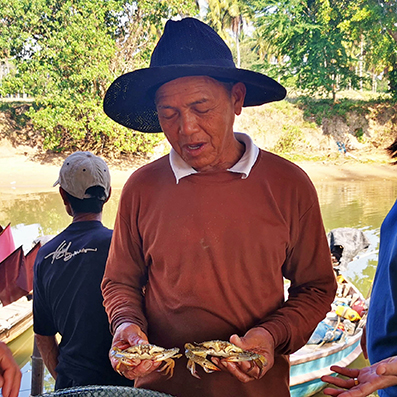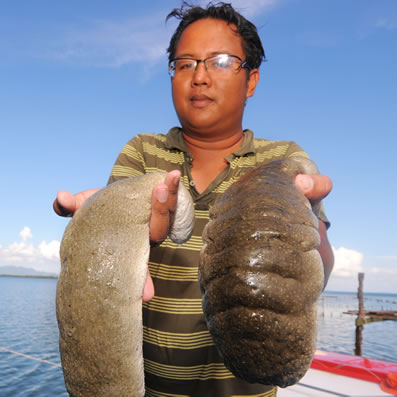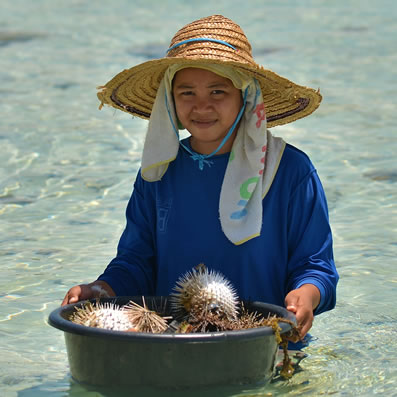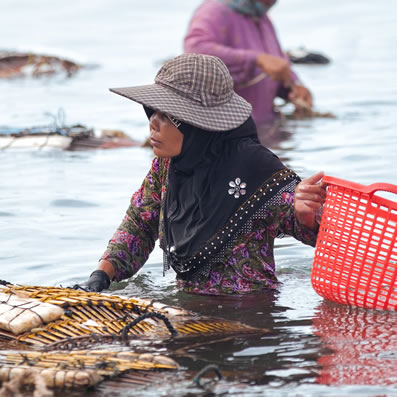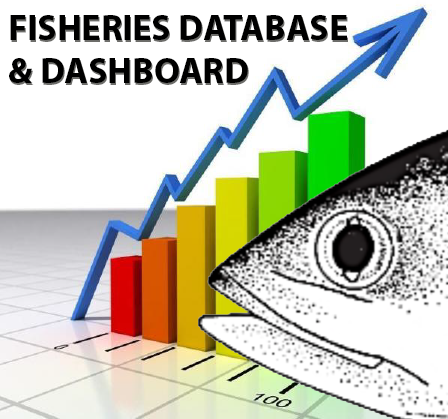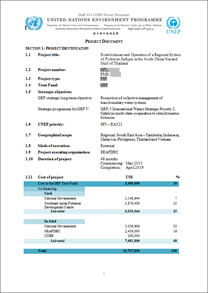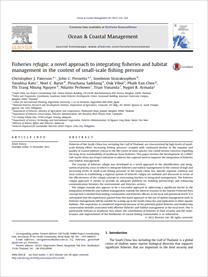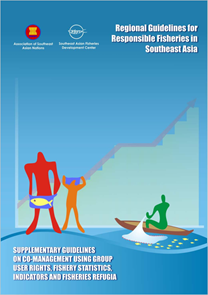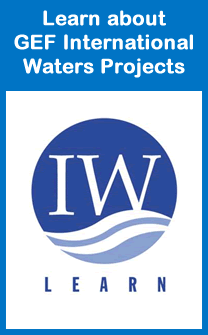THE SOUTH CHINA SEA FISHERIES REFUGIA INITIATIVE
FISHERIES REFUGIA PROJECT SITES
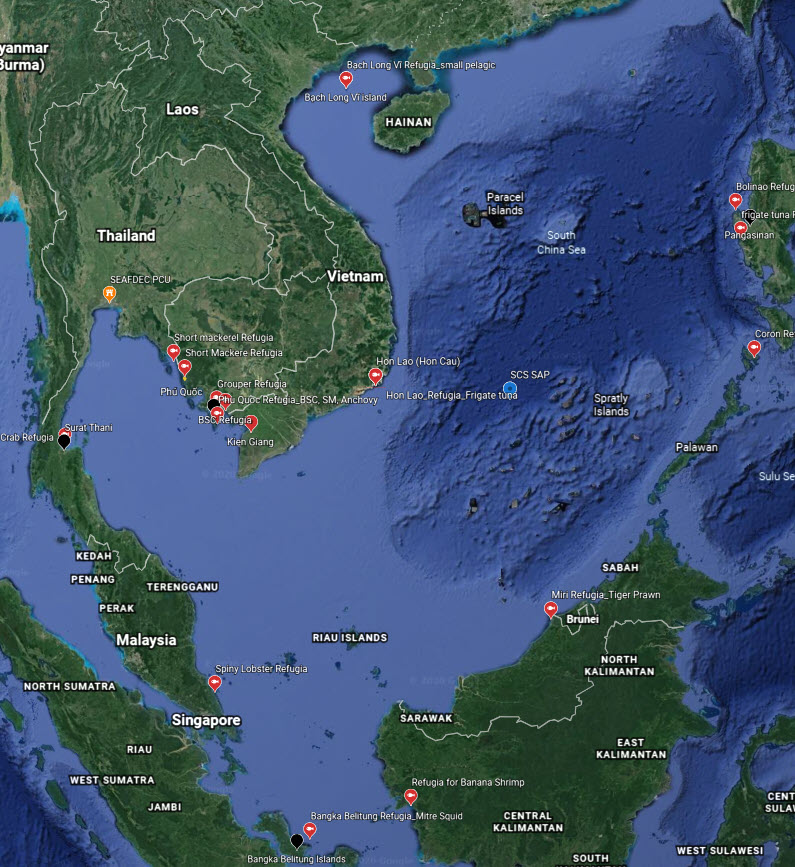 Click Here for
Click Here for More
Information
SCS SAP PRIORITY SITES (Habitat Linkages)
 All SCS SAP and
All SCS SAP and Fisheries Refugia
Priority Sites CHINA HABITAT
SITES CAMBODIA HABITAT
SITES INDONESIA HABITAT
SITES PHILIPPINES HABITAT
SITES THAILAND HABITAT
SITES VIET NAM HABITAT
SITES
Meet our Stakeholders
Social Media
Social Media
PROJECT INTRODUCTION
I. Introduction to Fisheries in the South China Sea and Gulf of Thailand
The South China Sea and Gulf of Thailand is a global center of shallow water marine biological diversity, supporting a significant world fishery of importance to the food security of, and as a source of export income for, Southeast Asian countries. Regional fisheries are significant in the context of food and nutritional security, and estimates of the value of fisheries production indicate that the contribution of capture fisheries to GDP are more than 2.0 percent in the majority of countries bordering the South China. Although since the majority of fisheries are small scale in nature, and land fish in a large number of decentralized landing places for distribution through complex marketing networks at the community level, estimates of the value of capture fisheries production are largely underestimated and do not adequately value the artisanal or subsistence part of the sector.
Landings from the Gulf of Thailand and the South China Sea contribute to approximately 10 percent of reported global fisheries production per annum. It is considered however that greater annual fluctuation in landings will be observed in the future as fisheries in both areas become increasingly on small pelagic fish species. This is largely due to the effects of the “fishing down the food chain” that has occurred quite notably in the Gulf of Thailand. Demersal fish species in the Gulf of Thailand and the South China Sea are fully exploited with evidence from resource assessments and fisher’s perceptions indicating that the catch per unit of effort for most demersal species is declining. This declining fish availability, coupled with over-capacity and the dependence on the small-scale sector on coastal fisheries for income generation has led to the adoption of destructive fishing practices such as blast fishing to maintain short-term incomes and food production.
II. Fisheries Management Issues in Southeast Asia
Fisheries management in the Gulf of Thailand and South China Sea must balance the interests of multiple jurisdictions, coastal community dependence on fisheries for food security, the problem of over-fishing, destructive fishing practices, incidental capture of endangered species, and the inherently complex nature of the tropical multi-species fisheries in the region. However, most marine fisheries in Southeast Asia are characterized by excess competition among fishers, and as such suffer from the problems of over-capitalization and over-exploitation. Illegal, Unregulated and Unreported fishing is also emerging as a critical fisheries management issue.
This situation has provided the impetus for the development of innovative approaches to moderate the tendency to over-exploit Southeast Asian fish resources. Significant efforts are being made throughout the region to decentralize the responsibility for fisheries management with an aim of establishing co-management approaches to fisheries. The notion of rights-based approaches to the management of the region’s small coastal fisheries is also gaining ascendancy. It is also well recognized that coral reef, seagrass, mangrove, and wetland habitats contribute significantly to the productivity of coastal fisheries, and act as refuges for the majority of fished species during critical phases of their lifecycles. Fisheries management involving decentralization and rights-based systems will need to incorporate strategies that aim to foster the critical links between the life-cycles of important fish species and coastal and marine habitats.
III. Challenges in Improving the Integration of Fisheries and Habitat Management
Ensuring the effective inclusion of fisheries issues into broader frameworks for coastal and marine management is an emerging policy challenge for the management of the South China Sea and Gulf of Thailand. Efforts to meet this challenge are constrained by:
- limited practical experience in the implementation of such fisheries management approaches, and
- low-level awareness of the extent of the partnerships required to effectively integrate fisheries and ecosystem management.
Experience in the region suggests that overcoming these challenges will require:
- improving the understanding amongst fishing communities, managers, and policy makers of ecosystem and fishery linkages, as a basis for integrated fisheries and habitat/ecosystem management, and
- building the capacity of both fisheries and environment ministries and departments to ensure that issues facing the fisheries sector are integrated into overall marine management frameworks.
Fisheries management strategies that focus on fish life-cycle and critical habitat linkages will need to ensure adequate cross sectoral consultation between fisheries and environment departments in the region, especially in relation to the designation of Marine Parks, Protected Areas, and Fisheries Management Areas. This will be required to ensure that areas designated for protection by environment ministries are whenever possible congruent with critically important areas for fish stocks.
IV. Establishing a Regional System of Fisheries Refugia
Regional Working Group on Fisheries (RWG-F) is collaborating with the Southeast Asian Fisheries Development Center (SEAFDEC) to
- Establish a system of fisheries refugia in the South China Sea and Gulf of Thailand that focuses on the critical links between fish stocks and their habitats.
The general longer-term objectives of this activity are to:
- Build the resilience of Southeast Asian fisheries to the effects of high and increasing levels of fishing effort,
- Improve the understanding amongst stakeholders, including fisher folk, scientists, policy-makers, and fisheries managers, of ecosystem and fishery linkages, as a basis for integrated fisheries and ecosystem/habitat management,
- Build the capacity of fisheries departments/ministries to engage in meaningful dialogue with the environment sector regarding how broader multiple use planning (in whatever form) can best contribute to improving the state of fisheries in areas of the South China Sea and the Gulf of Thailand.
|
The RWG-F Definition of Fisheries Refugia Fisheries refugia in the context of the UNEP/GEF South China Sea Project are defined as: “Spatially and geographically defined, marine or coastal areas in which specific management measures are applied to sustain important species [fisheries resources] during critical stages of their life cycle, for their sustainable use.” Fisheries refugia should: · NOT be “no take zones”, · Have the objective of sustainable use for the benefit of present and future generations, · Provide for some areas within refugia to be permanently closed due to their critical importance [essential contribution] to the life cycle of a species or group of species, · Focus on areas of critical importance in the life cycle of fished species, including spawning, and nursery grounds, or areas of habitat required for the maintenance of broodstock, · Have different characteristics according to their purposes and the species or species groups for which they are established and within which different management measures will apply, · Have management plans.
Management measures that may be applied within fisheries refugia may be drawn from the following [non-exhaustive] list: · Exclusion of a fishing method (e.g. light luring, purse seine fishing), · Restricted gears (e.g. mesh size), · Prohibited gears (e.g. push nets, demersal trawls), · Vessel size/engine capacity, · Seasonal closures during critical periods, · Seasonal restrictions (e.g. use of specific gear that may trap larvae), · Limited access and use of rights-based approaches in small-scale fisheries.
|
This initiative is considered important regionally because of the potential fisheries benefits associated with effective fisheries and habitat management at the local level. It is likely that the role of such approaches to fisheries management will become more important in the region, especially in the light of the continuing importance of fisheries to food security, nutritional security, and maintenance of livelihoods. Such approaches may also assist in curbing the effects of trends in regional fisheries relating to over-capacity and over-exploitation, the use of destructive fishing gear and practices, habitat destruction and pollution, and illegal fishing.
V. The Natural Refugia Concept in Fisheries
In evaluating the factors contributing to the resilience of fisheries to the resource-related effects of high levels of fishing effort, and how spatial fisheries management tools could effectively contribute to building resilience in Southeast Asian fisheries, the RWG-F has focused on the natural refugia concept in fisheries. Specifically, the group has considered the following “theoretical” natural refugia types and how they may relate to regional fisheries:
- Refugia related to depth stratification of the population or the selectivity of fishing gear causing parts of the population to have a very low probability of capture,
- Migrations to spawning area refugia located outside of the fishing grounds, and
- A refugia scenario where part of the population is located in the fishing ground, with another part of the population occupying areas that are not fished and providing a source of new recruits to the fished area.
During its Sixth Meeting in Sabah, Malaysia, 5th-8th September, 2005, the RWG-F felt uncomfortable associating any of the above refugia scenarios with important fishes in the region, largely due to a lack of information about the biology and population dynamics of most species at that time. There was, however, consideration of the role of refugia in fisheries of other regions, with discussion of the example of high recruitment and catches of hake in the Mediterranean during the 1980s despite a complete lack of input/output controls and a high percentage of juvenile fish being caught by inshore trawlers. It was pointed out that it is believed this occurred due to larger spawning fish occupying deeper areas of the continental shelf in refugia created by the inefficiency of the fine inshore trawls for large fish, and making a major spawning contribution to the adjacent fishery.
Regardless of the lack of readily available regional examples of the role of natural refugia, the group agreed that the identification of such refugia should be the focus of efforts to establish management areas for regional fisheries as:
- It is “refugia” that most likely contribute to the resilience of fisheries to the effects of fishing,
- The concept is likely to be more easily understood by fishers and align closely with the traditional knowledge of fishers, and
- It may be easier to manage these areas with limited research and monitoring, control and surveillance resources than other technical-based measures.
Several members of the group have highlighted that they find it difficult to believe that many of the above-mentioned natural refugia remain in areas such as the Gulf of Thailand, especially considering the:
- Multi-gear/sector/jurisdiction nature of fisheries,
- The combined problems of over-exploitation and community dependence on fisheries,
- Reported ecosystem effects of fishing, and the
- Large scale fisheries habitat losses associated with the development of shrimp farming activities.
Accordingly, the RWG-F is of the opinion that it will be very difficult to base fisheries refugia on actual natural refugia, and is promoting the use of the RWG-F definition of refugia (see Information Box 1) for the identification of fisheries refugia to “replace” those lost due to over-exploitation and the destruction of fisheries habitats. There is a common understanding that fisheries refugia relate to specific areas of significance to the life cycle of particular species, and that they should be defined in space and time, and serve to protect spawning aggregations, nursery grounds, and migratory routes.
SIMILARITIES AND DIFFERENCES BETWEEN SEASONAL CLOSURES, MARINE PROTECTED AREAS, AND THE CONCEPT OF FISHERIES REFUGIA DEVELOPED BY THE RWG-F
As the definition of fisheries refugia developed by the RWG-F focuses on sustainable use and clearly states that refugia will not be no-use areas, refugia cannot be substituted for permanent closures or no-take MPAs and vice versa. Refugia can, however, be compared to seasonal closures and multiple-use MPAs.
As outlined above, fisheries refugia will be established to maintain natural refugia and to create “replacement” refugia for those lost due to over-exploitation. In order to enable the countries involved to take some initial steps, the RWG-F definition of refugia has been framed broadly. The group has proposed that priority areas for refugia are those in which fish spawn and those in which juveniles seek shelter/food, and are initially looking at the identification of candidate refugia on this basis. This action is aimed at providing a starting point for a system of fisheries refugia in a situation where there is very little information about the location of natural refugia for the species they are dealing with.
Fisheries Refugia Diagram

Figure 1. The refugia types prioritised by the RWG-F in relation to the generalised life-cycle of demersal marine fishes
In this sense, fisheries refugia are very different to the general seasonal closures used in fisheries. Another important difference is based on the fact that the short-term area and seasonal closures commonly used in fisheries management (e.g. spot closures and closed seasons) are often implemented in small well-defined areas of fishing grounds. The fisheries refugia concept on the other hand, is based on areas of critical importance to the life-cycle of the species. This means that areas located outside the main fishing grounds for a given species, which are critical to the life-cycle for that species, qualify as fisheries refugia and can be managed accordingly. Such management for example, may include interventions aimed at reducing the impacts of the incidental capture of juveniles of a given species by another fishery operating in areas critical as inshore nursery refugia for that species. It may also include interventions to provide habitat protection, for example, to ensure that areas important for egg deposition are not disturbed, and/or to safeguard habitats that provide protection for juveniles from predators, such as mangroves and seagrass.
The group understands that individuals taking a “helicopter view” of the definition of refugia, and the initial actions of identifying important nursery and spawning areas, may misconstrue that the group is simply identifying areas for a regional system of seasonally managed areas (e.g. spot closures, closed seasons). An important role of the Fisheries Component of the SCS Project is to ensure that when such individuals take a “helicopter view” of this activity, they see a regional initiative working to (a) develop a system of fisheries refugia, including “replacement” of lost natural refugia, in order to build resilience in regional fisheries, and to (b) provide an institutional mechanism for improved fisheries and habitat management, i.e., management based on fisheries-critical habitat linkages. One aspect of this involves promoting the actions in terms of goals and objectives, rather than a working definition. General goals and objectives for this activity can be split into two categories: (a) resource-related and (b) institutional-related (see Table 1).
Table 1. Goals and objectives for a regional system of fisheries refugia.
|
Resource-Related Goal – Increased Resilience of Regional Fish Stocks to the Effects of Fishing |
Institutional-Related Goal – Fisheries and Habitat Management Conducted in an Integrated Manner |
|
Longer-Term Objectives · Increased average size of important species · Increased egg production of important species · Increased recruitment of important species · Increased biomass of important fish species |
Longer-Term Objectives · Community-based management of fisheries refugia for integrated fisheries and habitat management · National and regional level commitments for integrated fisheries and ecosystem management · Appropriately represented fisheries agenda in broader multiple use marine planning initiatives |
|
Shorter-Term Objectives · Safeguarding of natural refugia · Reduced capture of juveniles and pre-recruits of important species in critical fisheries habitats · Reduced targeting and capture of important species when forming spawning aggregations · Reduced targeting and capture of migrating fish |
Shorter-Term Objectives · Community-based management of fisheries refugia for fisheries management · Understanding amongst fishing communities of critical habitat and fish life-cycle linkages · Enhanced capacity of fisheries departments/ ministries to engage in meaningful dialogue with the environment sector |
Consideration of these goals and objectives enables one to evaluate whether or not areas subject to seasonal closures and fisheries management zones within multiple-use MPAs can be classified as fisheries refugia and form part of a regional refugia system. For instance, short term closures (or spot closures) are often implemented to redirect fishing effort from areas containing concentrations of juvenile fish or specific age classes of fish. Similarly, closed seasons are often implemented to safeguard spawning fish or to reduce the levels of fishing effort at times when pre-recruits are migrating to fishing grounds. A question regularly asked of the RWG-F is “do such spot closures and closed seasons qualify as fisheries refugia?” The answer to this question is “they do if the site has been selected in terms of achieving one or more of the resource-related objectives of the refugia system, and can be managed in the context of institutional-related goals and objectives for the regional system of refugia.”
A similar and perhaps more contentious question asked of the RWG-F is “do MPAs qualify as fisheries refugia and vice versa?” The simple answer to this question is no, especially if the MPA promotes the no-take concept in relation to fisheries. MPAs are implemented to limit human activity throughout a designated area of the ocean, with most aimed at achieving goals and objectives of biodiversity conservation. Similarly, the criteria for the identification of MPA sites usually relate to concepts of representativeness, comprehensiveness, and uniqueness, and a particular MPA cannot qualify as a fisheries refugium if the site was selected using these criteria. However, parts of multiple-use MPAs, such as fisheries management zones, may qualify as replacement fisheries refugium if:
- Such zones promote the concept of sustainable use rather than prohibition of fishing, and
- The selection of the zone was based on criteria relating to the critical linkage between the area and the life-cycle for which the area is managed.
However, it is essential that consideration be given to the fact that, if the site for a multiple-use MPA was identified using criteria that did not relate to fish life-cycle and critical habitat linkages, any fisheries management zone within that MPA may not be worthy of the research, financial, and management resources required for the development of that site as a fisheries refugium if compared to sites that were identified purely on critical habitat linkages. Similarly, poorly designed fisheries management zones within multiple-use MPAs may (a) lead to a loss of community support for spatial approaches to fisheries management, and (b) lead to the re-direction of fishing effort towards areas that are more important in terms of critical habitat linkages. Nevertheless, such zones should not be disregarded and may represent a class of refugia for consideration in any regional refugia system. Comparisons of the appropriateness of fisheries management zones within MPAs as refugia and fisheries refugia sites identified purely on the basis of fishery-critical habitat linkages will require the consideration of information relating to fish life-cycle and habitat associations at the fishery level.
